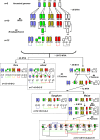Identification and characterization of shared duplications between rice and wheat provide new insight into grass genome evolution
- PMID: 18178768
- PMCID: PMC2254919
- DOI: 10.1105/tpc.107.056309
Identification and characterization of shared duplications between rice and wheat provide new insight into grass genome evolution
Abstract
The grass family comprises the most important cereal crops and is a good system for studying, with comparative genomics, mechanisms of evolution, speciation, and domestication. Here, we identified and characterized the evolution of shared duplications in the rice (Oryza sativa) and wheat (Triticum aestivum) genomes by comparing 42,654 rice gene sequences with 6426 mapped wheat ESTs using improved sequence alignment criteria and statistical analysis. Intraspecific comparisons identified 29 interchromosomal duplications covering 72% of the rice genome and 10 duplication blocks covering 67.5% of the wheat genome. Using the same methodology, we assessed orthologous relationships between the two genomes and detected 13 blocks of colinearity that represent 83.1 and 90.4% of the rice and wheat genomes, respectively. Integration of the intraspecific duplications data with colinearity relationships revealed seven duplicated segments conserved at orthologous positions. A detailed analysis of the length, composition, and divergence time of these duplications and comparisons with sorghum (Sorghum bicolor) and maize (Zea mays) indicated common and lineage-specific patterns of conservation between the different genomes. This allowed us to propose a model in which the grass genomes have evolved from a common ancestor with a basic number of five chromosomes through a series of whole genome and segmental duplications, chromosome fusions, and translocations.
Figures





Similar articles
-
Comparative DNA sequence analysis of mapped wheat ESTs reveals the complexity of genome relationships between rice and wheat.Funct Integr Genomics. 2004 Mar;4(1):34-46. doi: 10.1007/s10142-003-0098-2. Epub 2004 Jan 22. Funct Integr Genomics. 2004. PMID: 14740255
-
In silico comparative analysis reveals a mosaic conservation of genes within a novel colinear region in wheat chromosome 1AS and rice chromosome 5S.Funct Integr Genomics. 2004 Mar;4(1):47-58. doi: 10.1007/s10142-004-0103-4. Epub 2004 Feb 6. Funct Integr Genomics. 2004. PMID: 14767678
-
Diverged copies of the seed regulatory Opaque-2 gene by a segmental duplication in the progenitor genome of rice, sorghum, and maize.Mol Plant. 2008 Sep;1(5):760-9. doi: 10.1093/mp/ssn038. Epub 2008 Aug 1. Mol Plant. 2008. PMID: 19825579
-
The 'inner circle' of the cereal genomes.Curr Opin Plant Biol. 2009 Apr;12(2):119-25. doi: 10.1016/j.pbi.2008.10.011. Epub 2008 Dec 16. Curr Opin Plant Biol. 2009. PMID: 19095493 Review.
-
Comparative genomics in the grass family: molecular characterization of grass genome structure and evolution.Ann Bot. 2002 Jan;89(1):3-10. doi: 10.1093/aob/mcf008. Ann Bot. 2002. PMID: 12096816 Free PMC article. Review.
Cited by
-
Genome sequence of foxtail millet (Setaria italica) provides insights into grass evolution and biofuel potential.Nat Biotechnol. 2012 May 13;30(6):549-54. doi: 10.1038/nbt.2195. Nat Biotechnol. 2012. PMID: 22580950
-
Phylogenomics and Systematics of Overlooked Mesoamerican and South American Polyploid Broad-Leaved Festuca Grasses Differentiate F. sects. Glabricarpae and Ruprechtia and F. subgen. Asperifolia, Erosiflorae, Mallopetalon and Coironhuecu (subgen. nov.).Plants (Basel). 2022 Sep 2;11(17):2303. doi: 10.3390/plants11172303. Plants (Basel). 2022. PMID: 36079685 Free PMC article.
-
A BAC-based physical map of Brachypodium distachyon and its comparative analysis with rice and wheat.BMC Genomics. 2009 Oct 27;10:496. doi: 10.1186/1471-2164-10-496. BMC Genomics. 2009. PMID: 19860896 Free PMC article.
-
Phylogenetic footprint of the plant clock system in angiosperms: evolutionary processes of pseudo-response regulators.BMC Evol Biol. 2010 May 1;10:126. doi: 10.1186/1471-2148-10-126. BMC Evol Biol. 2010. PMID: 20433765 Free PMC article.
-
The genome of the domesticated apple (Malus × domestica Borkh.).Nat Genet. 2010 Oct;42(10):833-9. doi: 10.1038/ng.654. Epub 2010 Aug 29. Nat Genet. 2010. PMID: 20802477
References
-
- Altschul, S.F., Gish, W., Miller, W., Myers, E.W., and Lipman, D.J. (1990). Basic local alignment search tool. J. Mol. Biol. 215 403–410. - PubMed
-
- Bennetzen, J.L. (2005). Transposable elements, gene creation and genome rearrangement in flowering plants. Curr. Opin. Genet. Dev. 15 621–627. - PubMed
-
- Blake, N.K., Lehfeldt, B.R., Lavin, M., and Talbert, L.E. (1999). Phylogenetic reconstruction based on low copy DNA sequence data in an allopolyploid: The B genome of wheat. Genome 42 351–360. - PubMed
Publication types
MeSH terms
LinkOut - more resources
Full Text Sources
Other Literature Sources

